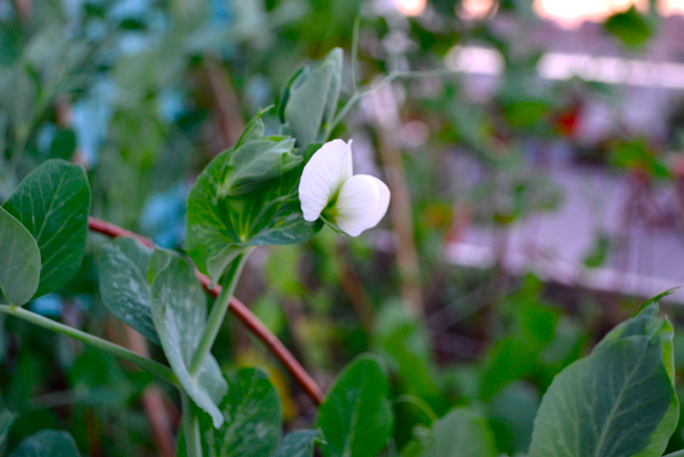
On Saturday, at St. Anslem in Williamsburg, I had the most delicious salad. Pea shoots, long beans, and grilled halloumi. Before Saturday, I’d never eaten pea shoots. Now I want to eat them for the rest of my life. Sweet and just chewy enough (like kale), they tasted like spring.
I share this because if you have limited outdoor space, you may be tempted to dismiss peas. After all, to get anything close to the number of pods necessary to fill even a moderate size bowl with peas may take more real estate than you have. But there are so many reasons to grow peas anyway! Let’s start with those pea shoots. Grow peas for the fast growing edible vines!
Then there’s the visual appeal. My pea plants have started to flower, and the graceful white blooms glow outside my window like little Mendelian ghosts. I love those flowers, but I love the pea plants perhaps most of all for their beautiful tendrils. Delicate and twining, they wrap around whatever trellis you offer. They wrap around each other too. They search for connection. There’s something so lost about them, and then so reassuringly found once they touch their home and begin their happy twirling.
And then, of course, there is the incomparable experience of fresh peas. Frozen peas are a wondrous thing. They’re good. They’re bountiful. They’re a year-round reliable. But fresh, uncooked peas, plucked from the vine, pinched one by one from their tender pods… Maybe you have space for only a handful of vines. Maybe they give you only a couple of dozen pods. But those pods may be the highlight of your summer.
So, let’s presume I’ve convinced you! Now, what do you need to know to grow them? Five simple things:
- Plant early. Peas are a cold weather crop. They thrive in the moderate temperatures of late spring and early summer. Most types of peas take roughly twelve weeks to go from seed in the soil to peas in your mouth. Plant in April, and you’ll have peas by July. If you plant in July (as I foolishly did last year), you may still be able to eek out a crop, but it’ll be nothing like the bumper crop you’ll have if you plant on time.
- Choose your variety. There are three main types of peas. Shelling peas, snap peas, and snow peas. With shelling peas, the shell is meant to be discarded. With snap peas, you can pop the peas and the pods right in your mouth. They’re equally delicious. With snow peas, the pod is the star of the show. For patios, I put my money on the snap peas. The best of both worlds.
- Plant them in the right spot. Peas will do fine in a container (mine are growing in containers right now, and they’re taking over the garden — in a good way). But you need to put the containers in the right location. Peas, like most vegetables, like sun, but they’ll also tolerate some shade. Find a spot that gives them at least five hours of sunlight a day.
- Water them. Peas like moderately moist soil. What does that mean for you? It means, make sure your pots have drainage holes in the bottom, and when it looks like the soil is getting dry, water them again. Since they’re a spring crop, April and May showers will do a lot of the work for you, but in dry conditions, don’t forget about them for more than three or four days.
- Give them some support. Remember those lovely tendrils I was talking about? Peas are climbing vines, and they need something to cling to. Bamboo stakes, architectural salvage, even just twigs pressed into the soil — peas are needy but they’re not picky.
And that, my friends, is it. I can’t wait to make that salad at home. I am off to the store to buy some halloumi this very second.
Tags: peas
Love it! I didn’t have my garden ready by April and fear I missed the bumper crop of peas. Sadness. Do you know if you can plant again in the late summer? And so excited to learn about pea shoots! Never tried them and can’t wait now! Beautiful post, Charity!